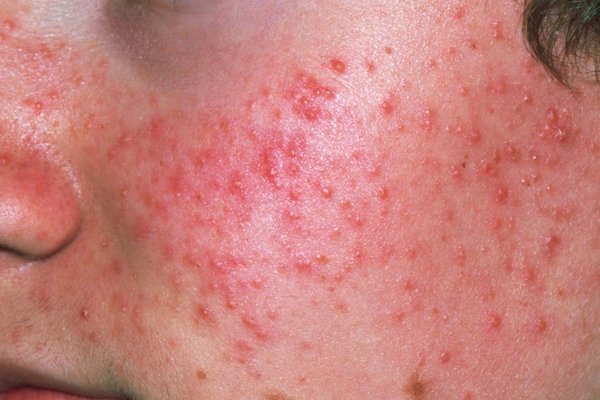Overview Of Acne
Acne is a chronic skin condition characterized by the clogging of hair follicles with oil and dead skin cells, leading to the formation of pimples, blackheads, and cysts. It primarily affects areas with a high density of sebaceous (oil) glands, such as the face, back, and chest.
Symptoms of Acne
- - Comedones: Blackheads (open comedones) and whiteheads (closed comedones) are non-inflammatory lesions resulting from clogged pores. - Inflammatory Lesions: Pimples, pustules, and cysts are inflamed lesions that can cause redness, swelling, and pain. - Scarring: Severe or untreated acne can lead to permanent scarring and skin discoloration.
Causes of Acne
- -
- Excess Oil Production: Overactive sebaceous glands produce more sebum than the skin needs, leading to clogged pores. -
- Hormonal Fluctuations: Changes during puberty, menstruation, pregnancy, or the use of birth control pills can increase androgen levels, stimulating oil production. ([Johns Hopkins Medicine](https://www.hopkinsmedicine.org/health/conditions-and-diseases/acne?utm_source=chatgpt.com)) -
- Bacterial Growth: The bacterium *Cutibacterium acnes* (formerly *Propionibacterium acnes*) thrives in clogged pores, contributing to inflammation. ([Wikipedia](https://en.wikipedia.org/wiki/Acne?utm_source=chatgpt.com)) -
- Clogged Pores: Accumulation of dead skin cells can block hair follicles, leading to acne. ([Healthline](https://www.healthline.com/health/skin/acne?utm_source=chatgpt.com)) -
- Diet and Lifestyle Factors: High-glycemic diets, stress, and certain medications can exacerbate acne. ([Wikipedia](https://en.wikipedia.org/wiki/Acne?utm_source=chatgpt.com))
Risk Factors of Acne
- - Age: Acne is common in teenagers but can affect adults. - Family history: Genetics play a significant role in susceptibility. - Hormonal changes: Puberty, menstruation, pregnancy, and birth control use can trigger acne. ([Johns Hopkins Medicine](https://www.hopkinsmedicine.org/health/conditions-and-diseases/acne?utm_source=chatgpt.com)) - Medications: Certain drugs, such as steroids, lithium, or anticonvulsants, can worsen acne. ([Penn Medicine](https://www.pennmedicine.org/for-patients-and-visitors/patient-information/conditions-treated-a-to-z/acne?utm_source=chatgpt.com)) - Diet: High-glycemic foods or dairy may aggravate acne. ([Wikipedia](https://en.wikipedia.org/wiki/Acne?utm_source=chatgpt.com))
Prevention of Acne
- - Consistent Skincare Routine: Gentle cleansing, moisturizing, and sun protection. - Avoid Picking or Squeezing Lesions: Prevents scarring and further inflammation. - Use Non-Comedogenic Products: Choose skincare and makeup labeled as non-comedogenic to prevent pore clogging. - Healthy Lifestyle Choices: Balanced diet, regular exercise, and stress management.
Prognosis of Acne
- Acne can improve with proper treatment but may recur. Treatment duration may vary based on severity.
Complications of Acne
- - Scarring: Permanent marks or indentations on the skin. - Hyperpigmentation: Dark spots or discoloration after lesions heal. - Psychological Impact: Acne can lead to anxiety, depression, and reduced self-esteem.
Related Diseases of Acne
- - Rosacea: A condition that mimics acne with facial redness and pimples. - Folliculitis: Inflammation of hair follicles often mistaken for acne. - Polycystic Ovary Syndrome (PCOS): Can cause hormonal imbalances that lead to acne.
Treatment of Acne
- **Topical Treatments**: - **Retinoids**: Promote cell turnover and prevent pore clogging. - **Benzoyl Peroxide**: Reduces *C. acnes* bacteria. - **Salicylic Acid**: Exfoliates the skin and unclogs pores. - **Oral Medications**: - **Antibiotics**: Reduce inflammation and bacterial growth. - **Oral Contraceptives**: Regulate hormones in females. - **Oral Retinoids**: Reserved for severe cases due to potential side effects. - **Procedural Treatments**: - **Chemical Peels**: Remove dead skin cells and reduce blockages. - **Laser Therapy**: Targets sebaceous glands and reduces inflammation.
Generics For Acne
Our administration and support staff all have exceptional people skills and trained to assist you with all medical enquiries.

Adapalene 0.1% Topical
Adapalene 0.1% Topical

Adapalene 0.1% + Benzoyl Peroxide 2.5%
Adapalene 0.1% + Benzoyl Peroxide 2.5%

Adapalene 0.3% Topical
Adapalene 0.3% Topical

Azelaic Acid 20%
Azelaic Acid 20%

Benzoyl Peroxide
Benzoyl Peroxide

Benzoyl Peroxide 5%
Benzoyl Peroxide 5%

Benzoyl Peroxide 5% + Erythromycin 3%
Benzoyl Peroxide 5% + Erythromycin 3%

Cefixime
Cefixime

Clindamycin 1%
Clindamycin 1%

Clindamycin Phosphate 1.2% + Tretinoin 0.025% Topical
Clindamycin Phosphate 1.2% + Tretinoin 0.025% Topical

Clobetasol Propionate 0.05% + Salicylic Acid 3% topical
Clobetasol Propionate 0.05% + Salicylic Acid 3% topical

Cyproterone Acetate + Ethinylestradiol
Cyproterone Acetate + Ethinylestradiol

Dapsone
Dapsone

Doxycycline
Doxycycline

Drospirenone + Ethinylestradiol
Drospirenone + Ethinylestradiol

Erythromycin
Erythromycin

Erythromycin solution
Erythromycin solution

Hydrous Benzoyl Peroxide 6.5%
Hydrous Benzoyl Peroxide 6.5%

Isotretinoin 0.05% Topical
Isotretinoin 0.05% Topical

Oxytetracycline
Oxytetracycline

Precipitated Sulpher 10% + Salicylic Acid 3%
Precipitated Sulpher 10% + Salicylic Acid 3%

Salicylic Acid 0.5% Topical
Salicylic Acid 0.5% Topical

Tazarotene 0.1% Topical
Tazarotene 0.1% Topical

Tetracycline Hydrochloride
Tetracycline Hydrochloride

Tretinoin Topical
Tretinoin Topical

Benzoyl Peroxide 4%
Benzoyl Peroxide 4%

Clarithromycin
Clarithromycin

Clindamycin
Clindamycin

Isotretinoin
Isotretinoin

Salicylic acid 2% Topical
Salicylic acid 2% Topical

Sulphar + salicylic acid (10% & 3% ) Topical
Sulphar + salicylic acid (10% & 3% ) Topical

Sulphonated Surfactant
Sulphonated Surfactant

Sodium Fusidate 2% Topical
Sodium Fusidate 2% Topical

Adapalene 0.1% Topical
Adapalene 0.1% Topical

Adapalene 0.1% + Benzoyl Peroxide 2.5%
Adapalene 0.1% + Benzoyl Peroxide 2.5%

Adapalene 0.3% Topical
Adapalene 0.3% Topical

Azelaic Acid 20%
Azelaic Acid 20%

Benzoyl Peroxide
Benzoyl Peroxide

Benzoyl Peroxide 5%
Benzoyl Peroxide 5%

Benzoyl Peroxide 5% + Erythromycin 3%
Benzoyl Peroxide 5% + Erythromycin 3%

Cefixime
Cefixime

Clindamycin 1%
Clindamycin 1%

Clindamycin Phosphate 1.2% + Tretinoin 0.025% Topical
Clindamycin Phosphate 1.2% + Tretinoin 0.025% Topical

Clobetasol Propionate 0.05% + Salicylic Acid 3% topical
Clobetasol Propionate 0.05% + Salicylic Acid 3% topical

Cyproterone Acetate + Ethinylestradiol
Cyproterone Acetate + Ethinylestradiol

Dapsone
Dapsone

Doxycycline
Doxycycline

Drospirenone + Ethinylestradiol
Drospirenone + Ethinylestradiol

Erythromycin
Erythromycin

Erythromycin solution
Erythromycin solution

Hydrous Benzoyl Peroxide 6.5%
Hydrous Benzoyl Peroxide 6.5%

Isotretinoin 0.05% Topical
Isotretinoin 0.05% Topical

Oxytetracycline
Oxytetracycline

Precipitated Sulpher 10% + Salicylic Acid 3%
Precipitated Sulpher 10% + Salicylic Acid 3%

Salicylic Acid 0.5% Topical
Salicylic Acid 0.5% Topical

Tazarotene 0.1% Topical
Tazarotene 0.1% Topical

Tetracycline Hydrochloride
Tetracycline Hydrochloride

Tretinoin Topical
Tretinoin Topical

Benzoyl Peroxide 4%
Benzoyl Peroxide 4%

Clarithromycin
Clarithromycin

Clindamycin
Clindamycin

Isotretinoin
Isotretinoin

Salicylic acid 2% Topical
Salicylic acid 2% Topical

Sulphar + salicylic acid (10% & 3% ) Topical
Sulphar + salicylic acid (10% & 3% ) Topical

Sulphonated Surfactant
Sulphonated Surfactant

Sodium Fusidate 2% Topical
Sodium Fusidate 2% Topical


